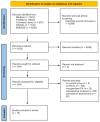Effects of Supervised Exercise on the Development of Hypertensive Disorders of Pregnancy: A Systematic Review and Meta-Analysis
- PMID: 35160245
- PMCID: PMC8836524
- DOI: 10.3390/jcm11030793
Effects of Supervised Exercise on the Development of Hypertensive Disorders of Pregnancy: A Systematic Review and Meta-Analysis
Abstract
Hypertensive disorders of pregnancy (HDP) are the most common medical complication in pregnancy, affecting approximately 10-15% of pregnancies worldwide. HDP are a major cause of maternal and perinatal morbidity and mortality, and each year, worldwide, around 70,000 mothers and 500,000 babies die because of HDP. Up-to-date high-quality systematic reviews quantifying the role of exercise and the risks of developing HDP are currently lacking. Physical exercise is considered to be safe and beneficial to pregnant women. Supervised exercise has been shown to be safe and to be more beneficial than unsupervised exercise in the general population, as well as during pregnancy in women with obesity and diabetes. Therefore, we undertook a systematic review and meta-analysis to investigate the effects of women performing supervised exercise during pregnancy compared to a control group (standard antenatal care or unsupervised exercise) on the development of HDP. We searched Medline, Embase, CINHAL, and the Cochrane Library, which were searched from inception to December 2021. We included only randomized controlled trials (RCTs) investigating the development of HDP compared to a control group (standard antenatal care or unsupervised exercise) in pregnant women performing supervised exercise. Two independent reviewers selected eligible trials for meta-analysis. Data collection and analyses were performed by two independent reviewers. The PROSPERO registration number is CRD42020176814. Of 6332 articles retrieved, 16 RCTs met the eligibility criteria, comparing a total of 5939 pregnant women (2904 pregnant women in the intervention group and 3035 controls). The risk for pregnant women to develop HDP was significantly reduced in the intervention compared to the control groups, with an estimated pooled cumulative incidence of developing HDP of 3% in the intervention groups (95% CI: 3 to 4) and of 5% in the control groups (95% CI: 5 to 6), and a pooled odds ratio (OR) comparing intervention to control of 0.54 (95% CI:0.40 to 0.72, p < 0.001). A combination of aerobic and anaerobic exercise, or yoga alone, had a greater beneficial effect compared to performing aerobic exercise only (mixed-OR = 0.50, 95% CI:0.33 to 0.75, p = 0.001; yoga-OR = 0.28, 95% CI:0.13 to 0.58, p = 0.001); aerobic exercise only-OR = 0.87, 95% CI:0.55 to 1.37, p = 0.539). Pregnancy is an opportunity for healthcare providers to promote positive health activities, thus optimizing the health of pregnant women with potential short- and long-term benefits for both mother and child. This systematic review and meta-analysis support a beneficial effect of either structured exercise (combination of aerobic, strength, and flexibility workouts) or yoga for preventing the onset of HDP. Yoga, considered a low-impact physical activity, could be more acceptable and safer for women in pregnancy in reducing the risk of developing HDP.
Keywords: exercise; gestational hypertension; meta-analysis; physical activity; pre-eclampsia; systematic review.
Conflict of interest statement
T.Y. reports receiving grants from NIHR Leicester BRC during the study. The remaining authors declare no conflict of interest.
Figures





Similar articles
-
Folic acid supplementation and malaria susceptibility and severity among people taking antifolate antimalarial drugs in endemic areas.Cochrane Database Syst Rev. 2022 Feb 1;2(2022):CD014217. doi: 10.1002/14651858.CD014217. Cochrane Database Syst Rev. 2022. PMID: 36321557 Free PMC article.
-
The effect of weight management interventions that include a diet component on weight-related outcomes in pregnant and postpartum women: a systematic review protocol.JBI Database System Rev Implement Rep. 2015 Jan;13(1):88-98. doi: 10.11124/jbisrir-2015-1812. JBI Database System Rev Implement Rep. 2015. PMID: 26447010
-
Association between pregnancy-related complications and development of type 2 diabetes and hypertension in women: an umbrella review.BMC Med. 2024 Feb 14;22(1):66. doi: 10.1186/s12916-024-03284-4. BMC Med. 2024. PMID: 38355631 Free PMC article.
-
Effect of Physical Activity during Pregnancy on the Risk of Hypertension Disorders and Gestational Diabetes: Evidence Generated by New RCTs and Systematic Reviews.J Clin Med. 2024 Apr 11;13(8):2198. doi: 10.3390/jcm13082198. J Clin Med. 2024. PMID: 38673471 Free PMC article. Review.
-
Exercise during pregnancy for preventing gestational diabetes mellitus and hypertensive disorders: An umbrella review of randomised controlled trials and an updated meta-analysis.BJOG. 2023 Feb;130(3):264-275. doi: 10.1111/1471-0528.17304. Epub 2022 Oct 17. BJOG. 2023. PMID: 36156844 Free PMC article.
Cited by
-
Rural-urban residence and sequelae of hypertensive disorders of pregnancy in the first year postpartum, 2007 - 2019.Pregnancy Hypertens. 2023 Jun;32:10-17. doi: 10.1016/j.preghy.2023.02.002. Epub 2023 Feb 14. Pregnancy Hypertens. 2023. PMID: 36822069 Free PMC article.
-
High-intensity interval training is an effective exercise mode to maintain normal blood pressure during pregnancy: a randomized control trial.Sci Rep. 2024 Nov 14;14(1):27975. doi: 10.1038/s41598-024-79552-3. Sci Rep. 2024. PMID: 39543304 Free PMC article. Clinical Trial.
-
A Review of Dietary and Lifestyle Management of Pre-Eclampsia and Postpartum Eclampsia.Prev Nutr Food Sci. 2025 Feb 28;30(1):1-20. doi: 10.3746/pnf.2025.30.1.1. Prev Nutr Food Sci. 2025. PMID: 40059912 Free PMC article. Review.
-
Effects of physical exercise on blood pressure during pregnancy.BMC Public Health. 2022 Sep 12;22(1):1733. doi: 10.1186/s12889-022-14074-z. BMC Public Health. 2022. PMID: 36096756 Free PMC article.
-
Preeclampsia: Etiology, Pathophysiology, Risk Factors, Impact and Prevention: A Narrative Review.Iran J Public Health. 2024 Nov;53(11):2392-2403. doi: 10.18502/ijph.v53i11.16941. Iran J Public Health. 2024. PMID: 39619908 Free PMC article. Review.
References
Publication types
Grants and funding
LinkOut - more resources
Full Text Sources
Miscellaneous

